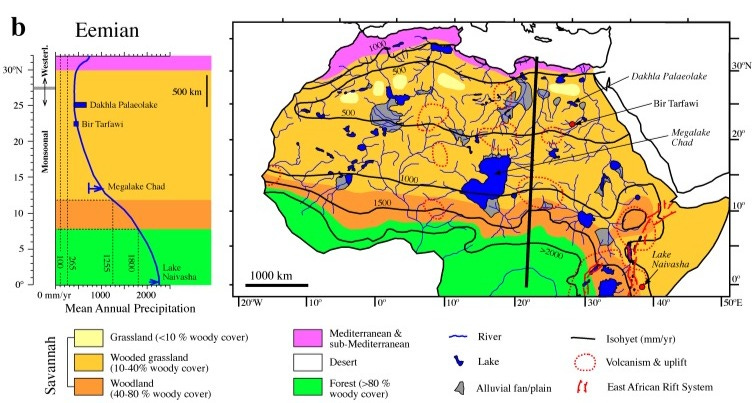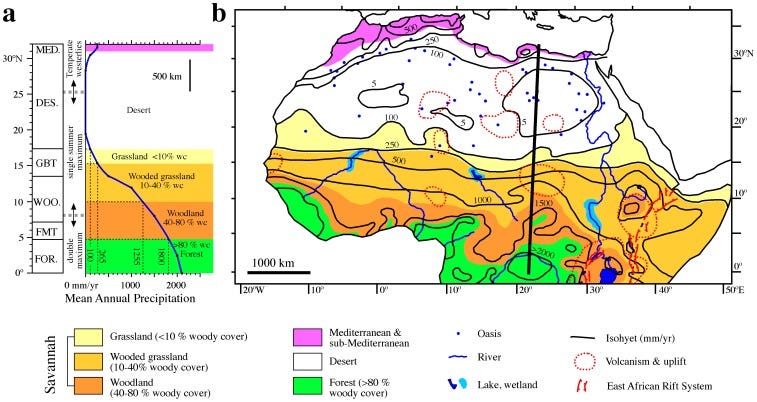
Know this—tropical forests generally thrive in warmer climates. In fact, they usually expand.
So talk of a climatic tipping point that would take down the Amazon rainforests, such as the Nature computer modeling study published a couple of weeks ago, misses the mark. The authors fail to put blame for rainforest decline where it belongs—on deforestation due to human activity.
We saw some signs of the problem in late May with high-resolution forest cover data, described in Friday’s Eco-Logic post. Tree cover loss in the tropics spiked in 2024, with roughly half of the decline attributed to fire.
Fires in the Amazon rainforest rarely occur naturally, as a regional expert in Brazil noted. They start because people start them. They spread if conditions are dry.
During past climates when global temperatures reached higher than today, rainforests expanded. Forests in general expanded, but I’ll focus on tropical rainforests. They’re so lush and productive, we really count on them to vacuum up a lot of the heat-trapping carbon dioxide we release when we burn coal, oil, gas and, yes, forests.
Their loss would really throw our planetary defenses to climate change out of whack.
I spent years of Ph.D. and postdoctoral work considering how and why forests expand during hot climates, as well as tens of thousands of words in my 2010 University of Arizona Press book, Life in the Hothouse: How a Living Planet Survives Climate Change.
Here, I’ll summarize a few of the underlying concepts in 1,600 words, using updated references and context.

Rainforests expand in hot climates
About 50 million years ago, during the Early Eocene—when planetary temperature ran about 20 degrees Fahrenheit higher—tropical rainforests covered a larger chunk of the planet than they do today.
That holds even when comparing Eocene forests to those before humans began razing them to grow rice, wheat and other crops.
About 100 million years ago, during the mid-Cretaceous, ancient Arctic forests thrived around the poles. Research made headlines by exposing the fossilized remnants of 100,000-year-old forests featuring Dawn redwoods in the Arctic. Then in the Antarctic.
But tropical trees didn’t vanish. During the mid-Cretaceous, which a 2021 study estimates was likely 12 to 15 degrees Fahrenheit hotter globally than today, the tropics continued to support forests around the tropics. And the Cretaceous featured the rise of flowering plants, which research suggests led to the evolution by about 80 million years ago of tree communities identifiable as tropical rainforests.
Even during the most recent period that was warmer than our modern-day baseline—the Eemian interglacial warm period that started about 130,000 years ago—forests expanded. For instance, there’s abundant evidence that the Sahara region of Africa greened up during this time frame.
This map of northern Africa shows the how open forests (light orange) expanded across what is now the Sahara Desert during the warmer interglacial period known as the Eemian. Image used with permission of Open Access license.
Interglacials are the relatively brief warm periods sandwiched between the recurring ice ages of the past 2.6 million years. The Eemian preceded our planet’s most recent ice age, when ice sheet expanded, crushing forests in areas now hosting modern Chicago and Manhattan.
During the Eemian—which, unlike the Eocene was only slightly warmer than our jacked-up temperatures of the last decade—trees expanded across the Sahara Desert.
They didn’t grow densely enough to form a closed canopy, as rainforests typically do, but their canopy blocked an estimated 10 to 40 percent of incoming rays of sunshine.
They provided enough shade, then, for early humans—hominins, in this context—to meander up from Africa to Europe without getting scorched. That’s the hypothesis of a trio of researchers led by Juan C. Larrasoaña, anyway, as reported in the scientific journal PLOS ONE.
Their hypothesis makes sense. It’s grounded in evidence of tree pollen and lake sediments from that time frame. In the harsh conditions of the modern Sahara, pedestrians would rarely if ever survive attempts to cross it.
This map of northern Africa shows the current large expanse of Sahara Desert (white). Image used with permission of Open Access license.
Their research also fits in with the general picture pieced together by others that forests, including rainforests, expanded during warmer climates of the past. Meanwhile, they generally contracted during ice ages, even in places where they weren’t turned into toothpicks by advancing glaciers and ice sheets.
Ice age changes
In the Amazon, ice ages ushered in more seasonal forest species to replace the evergreen species found during warmer periods, including the modern interglacial. Lower carbon dioxide levels, rainfall and temperatures during the ice ages still supported trees, but a 2023 study in Quaternary Science Reviews indicates the continuous full-canopy-cover, year-round evergreen forests of modern times appears to have thrived mainly during warm periods.
Still, fires likely were uncommon, based on an 800,000-year-long record of pollen and charcoal, when it occurs, taken from a high-elevation site in the Andes. The research reported in 2023 in Nature Communications found evidence of charcoal almost non-existent before humans arrived on the scene, although it did show some evidence for a few fires during the Eemian.
The Eemian charcoal evidence pales in comparison to the charcoal evidence for fires for the past 13,000 years, though. As the authors note, the latest interglacial of today “stands out as having an almost ubiquitous charcoal presence in sediment samples,” suggesting humans were involved in the documented increase in fires.

It’s not the heat, it’s the humidity
Perhaps the usual expansion of rainforests and forests in general shouldn’t be surprising, given that we live on a planet covered mostly with water. It takes a certain amount of rainfall, which varies depending on evaporation rates, to support the wood-constructing habit of trees.
In general, you’ll find forests where there’s abundant rainfall or snow cover. Grasslands exist where it’s either too wet for most trees or so dry that seasonal fires spark. Deserts often occur where hot climates pair with recurring high-pressure systems that suppress rainclouds.
Reasons abound for why warmer air and sea surface temperatures spur on more rainfall, whether as part of monsoons, hurricanes or everyday thunderstorms. Changes or variations in circulation patterns play a role too.
But for now, let’s focus on one basic underlying reason for increased rainfall during warmer climates: Higher temperatures boost evaporation rates.
On a planet with a surface that’s roughly 71 percent water, that adds up.
Basically, the water-holding capacity of air roughly doubles with each temperature increase of about 20 degrees Fahrenheit.
This means air in hothouse climates such as the Early Eocene and mid-Cretaceous held about double the water as our modern-day air does, given the huge difference in temperature. That’s a lot of extra water that would eventually come down as precipitation, especially rainfall.
Rainforests survive, but cities would flood
Let me just say right here that the hothouse climates of the Eocene and Cretaceous would challenge our modern civilization well beyond what we’re dealing with now. Seas would rise hundreds of feet higher. Storms, including hurricanes, would become even more severe on a hotter, even-more-watery world.
Even the Eemian’s sea level rise of 20 to 30 feet would wreak havoc on our built-up coastlines.
So, just so it’s clear, I’m not advocating that we can sit back and allow temperatures to keep rising. The more we do to rein in the release of heat-trapping gases and their capture by forests, the better our chances will be at keeping our rainforests safe from tipping points.
I am saying this, though: Even under the extreme heat and moisture of the geologic past, rainforests thrived in the tropics. So, if rainforests are disappearing in real time, it’s quite unlikely the higher temperatures, or even the climatic conditions that naturally accompany them, are the true source of the problem.
A February 2024 Brazilian-led Nature paper on tipping points is more nuanced than the more recent one from May. Four of the “five critical drivers of climate stress” relate to climatic conditions, but one driver pins some blame on deforestation and fire.
The authors suggest stabilizing global climate should be the top priority. Still, they do recommend assuming a deforestation rate of 10 percent might be the maximum the Amazon can handle at one time. As they note, this means deforestation would need to stop. It would also require efforts to restore some portion of the approximately 13 to 15 percent of the Amazon currently lacking forest cover.
Why does this matter?
It may seem a moot point to argue about this. If the lush Amazon rainforest shifts into a less forested, savannah-like system, does it really matter what causes it?
Absolutely.
The two main perceived drivers of a potential tipping point, climate change and deforestation, operate at different scales and with different inputs.
Climate change is global. It’s tough to rein in because it requires cooperation among diverse governments as well as multinational corporations.
It doesn’t help that the United States dropped out of international negotiations the day after Donald Trump took office, much as in 2017. His vision of dragging us back into the polluted era of coal, oil and gas takes us in the wrong direction, as does the exploding global energy needs of artificial intelligence.
Still, if forests, especially tropical rainforests, thrive in warmer climates, that suggests that warmer climates do not tip forests into savannah.
Deforestation, then, becomes the most likely culprit. It’s the main reason rainforests would falter in a warmer climate.
Deforestation occurs at a local and regional level. Because of this, action must occur at the local and regional level—although global forces could support this, such as by avoiding purchases that contribute to tropical deforestation and by supporting incentives that protect tropical rainforests.
Where Indigenous peoples and conscientious local people steward the forest without interference, diverse plants and animals, including humans, form an interconnected community of support—for each other and the planet.
Financial incentives could support them rather than the corporations and cattle ranchers currently decimating the remaining Amazon forest.
As more scientists and environmental activists become aware of the rainforests’ importance in stabilizing climate in diverse ways—including well beyond the removal and storage of carbon dioxide—we may see more willingness to provide such financial incentives internationally.
As it is, concern over fires that could release stored carbon often stymies these efforts.
We really need to move past the false narrative that it’s hotter temperatures rather than deforestation at the root of a potential tropical rainforest tipping point.
If enough concerned parties agreed on this source of the problem, that could lead to a tipping point of its own—one where forest protection shifts into playing a key role for reasons that extend well beyond carbon storage.
That’s a tipping point I would welcome.
On Thursday, I’ll expand upon this concept to consider some of the rainforest services overlooked by the computer models projecting pending tipping points.






Thank you Dr Lenart, for sharing your considerable understanding of this topic. The light you are shedding is crucial and has been so misconstrued. Thank you for taking a stand and making it easy for us to share through your efforts.
so interesting. sounds like this theory may work well with the earth warming?